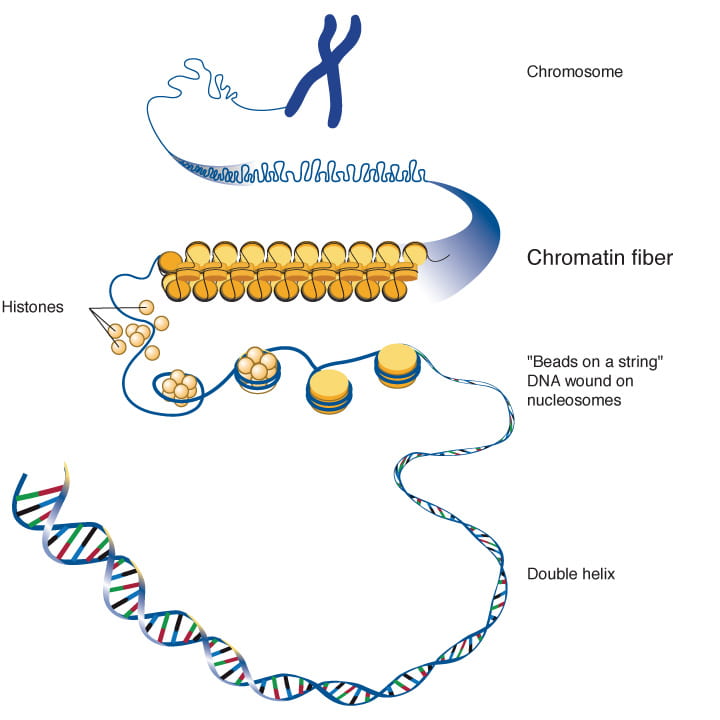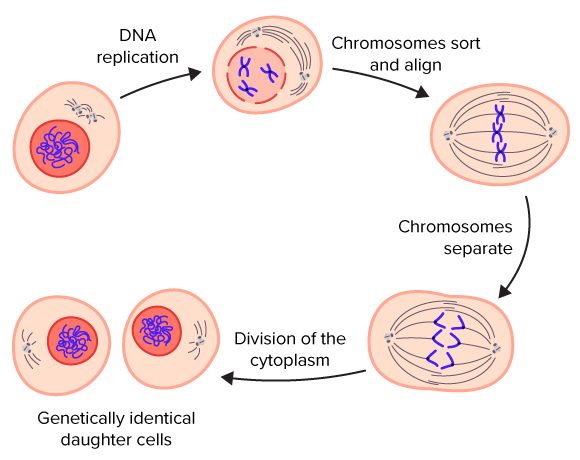Explain How a Cell Could End Up With Multiple Nuclei
CMTs arising from the SPB grow and shrink but do so more slowly than cMTs in animal cells Carminati and Stearns 1997. In addition to human cells certain types of fungi have multinucleated cells.

Cell Division Mitosis And Meiosis Biological Principles
Because DNA has already replicated each chromosome.

. Muscle cells and muscle fibers have many nuclei because these cells arise from a fusion of myoblasts. Cytokensis doesnt take place. While several associated proteins help actin and myosin form thick and thin filaments which slide past each other to contract small units of a muscle cell.
A muscle cell known technically as a myocyte is a specialized animal cell which can shorten its length using a series of motor proteins specially arranged within the cell. The spores germinant divide to form multicellular haploid gametophytes. Before being fused the myoblasts each have their own nucleus.
From Latin nucleus or nuculeus meaning kernel or seed is a membrane-enclosed organelle found in eukaryotic cells. Most commonly some cells end up with one extra or missing chromosome for a total of 45 or 47 chromosomes per cell while other cells have the usual 46 chromosomes. Each cell has multiple nuclei.
Explain how a cell could end up with multiple nuclei. The spores germinate divide to form multi-cellular haploid gametophytes. View the full answer.
Mosaic Turner syndrome is one example of chromosomal mosaicism. Mitosis is a single nuclear division that results in two nuclei that are usually partitioned into two new cells. A skeletal muscle cell is formed by fusion of multiple muscle cells and during this process the c.
Author summary How the cell organizes its interior is one of the fundamental biological questions but the principles of organelles positioning remains largely unclear. Nuclei can be pushed when growing cMTs hit the cortex Shaw et al 1997. Chromosomal mosaicism occurs from an error in cell division in cells other than eggs and sperm.
As these cardiac cells cannot divide satellite cells are responsible for replacing the damaged ones. Skeletal muscle cells are multinucleated. Similarlymuscle fibres also have more than one nuclei in one cell.
Except when a eukaryotic cell divides its nuclear DNA exists as a grainy material called chromatin. Skeletal muscle cells are multi-nucleated. In cell biology the nucleus pl.
Multinucleated cells multiple nuclei share one common cytoplasm in eukaryotes are formed by the mitosis in which nuclear division takes place not being followed by cytokinesis coenocytes or cell fusion syncytia. Multinucleation is one mechanism adopted by cells to generate and sustain large cell sizes. Cell nuclei contain most of the cells genetic material organised as multiple long linear DNA molecules in complex with a large variety of proteins such as histones to form chromosomes.
Smooth muscle cells are arranged together in sheets and this organisation means that they can contract simultaneously. Cancerous cells and those infected with viruses can also have multiple nuclei at times. Each cell has multiple nuclei.
After being fused together the multiple myoblasts become a muscle fiber that has multiple nuclei. Muscle cells are one of the largest cell types which are formed by fusion of mononucleated myoblasts and contain up to several tens invertebrates to several hundred vertebrates nuclei. Only when a cell is about to divide and its DNA has replicated does DNA condense and coil into the familiar X-shaped form of a chromosome like the one shown in Figure PageIndex2.
Muscle Cell Definition. During the life cycle of plants haploid spores are produced. Just as a tissue can be separated into its living constituent cell types so the cell can be separated into its functioning organelles and macromolecules.
Science Biology BIOL 1010. In this study we use computational modeling and image analysis to elucidate mechanisms of positioning of multiple nuclei in muscle cells. They share some similarities but also exhibit distinct differences that lead to very different outcomes Figure 6.
The genes within these chromosomes. Explain how a cell could end up with multiple nuclei. During the life cycle of plants haploid spores are produced.
A 12 D The cell underwent repeated mitosis but cytokinesis did not occur. The Forms of DNA. We start with the general hypothesis supported by published.
They form by fusion of mononucleated progenitors and can accumulate many nuclei in a single large cell. A more recent proposal the exomembrane hypothesis suggests that the nucleus instead originated from a single ancestral cell that evolved a second exterior cell membrane. Later the myoblasts cells fuse together and give rise to multinucleated muscle fiber therefore have multiple nuclei each nucleus originating from a single myoblast.
Explain how a cell could end up with multiple nuclei. What kind of nuclear division mitosis or meiosis do the spores undergo. The nuclei resulting from a mitotic division are genetically identical to the original nucleus.
Although biochemical analysis requires disruption of the anatomy of the cell gentle fractionation techniques have been devised to separate the various cell components while preserving their individual functions. Different modes of cMT plus-end capture and pulling on cMTs direct nuclei during the cell cycle of S. The interior membrane enclosing the original cell then became the nuclear membrane and evolved increasingly elaborate pore structures for passage of internally synthesized cellular.
Smooth muscle cells are elastic not striated spindle-shaped and contain a single central nucleus.

Mastering Complexity Towards Bottom Up Construction Of Multifunctional Eukaryotic Synthetic Cells Trends In Biotechnology

Cell Division Ck 12 Foundation

Genes And Chromosomes 2 Cell Division And Genetic Diversity Nursing Times
No comments for "Explain How a Cell Could End Up With Multiple Nuclei"
Post a Comment